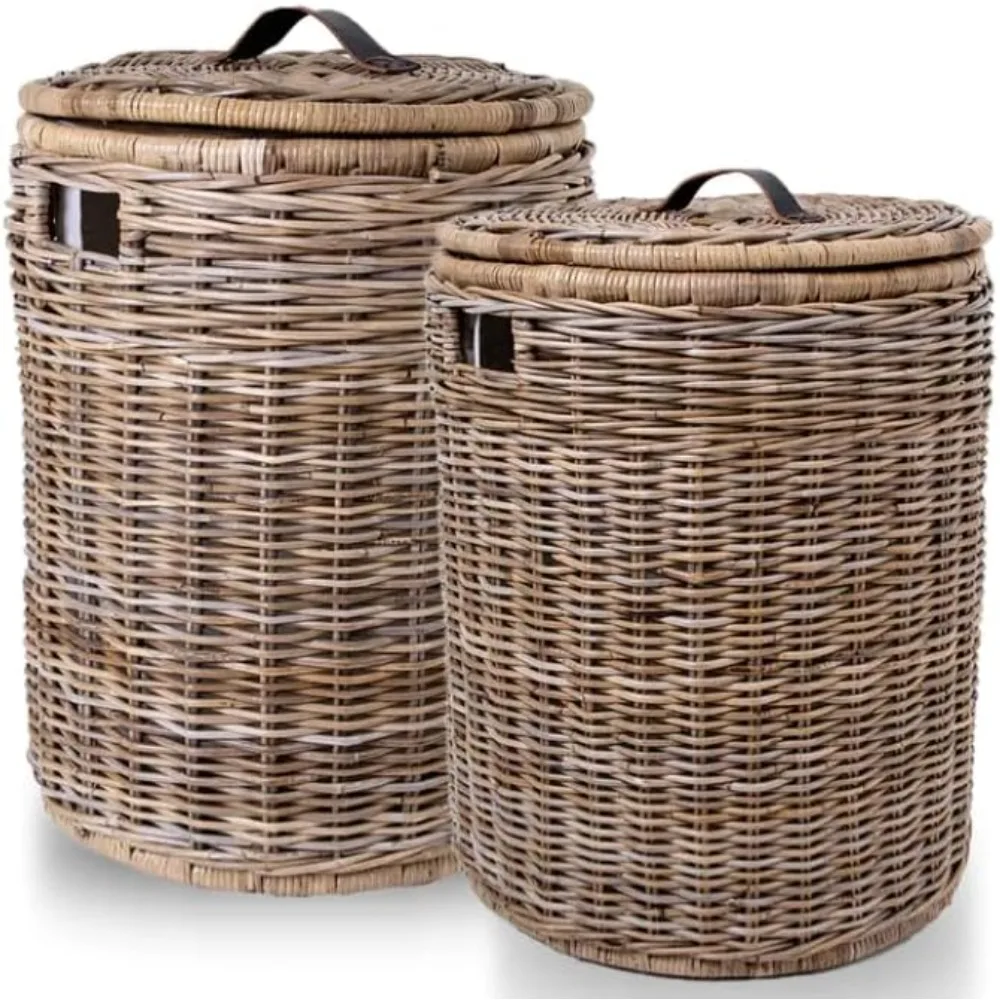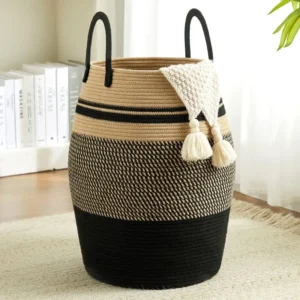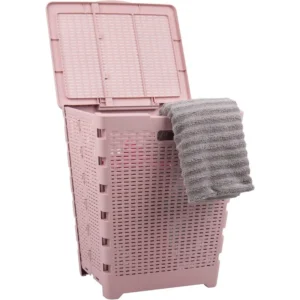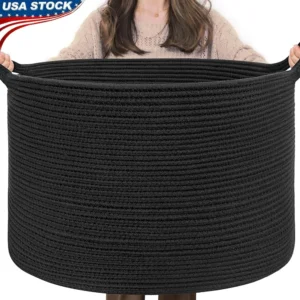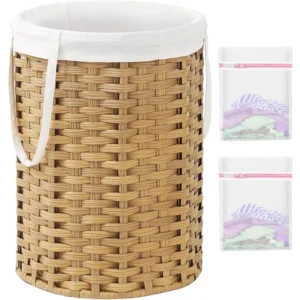What Are Laundry Hampers and Baskets?
When organizing your laundry routine, two essential items often come into play: laundry hampers and laundry baskets. Though sometimes used interchangeably, these two laundry companions serve distinct purposes in keeping your home tidy and your laundry process efficient.
Laundry hampers are primarily designed for storing dirty clothes until it’s time to wash them. They typically stand taller than they are wide and often feature lids to conceal contents and contain odors. On the other hand, laundry baskets focus on transportation – they’re wider, more open, and include handles for easily carrying clothes to and from the washing machine.
Understanding the fundamental differences between choosing between hampers and baskets helps determine which option best suits your laundry needs or whether you might benefit from having both.
| Feature | Laundry Hamper | Laundry Basket |
|---|---|---|
| Primary Purpose | Storage of dirty clothes | Transportation of laundry |
| Design | Tall, often lidded | Wide, open-top with handles |
| Placement | Bedroom, bathroom, closet | Near laundry facilities, mobile |
| Typical Use | Collecting clothes over time | Moving clothes to/from washer |
Understanding Laundry Hampers: Design & Purpose
Laundry hampers serve as dedicated stations for collecting dirty clothes until laundry day arrives. Their design prioritizes convenient storage while keeping soiled items contained and out of sight.
Key characteristics of laundry hampers include:
- Form factor: Typically taller than wide, maximizing vertical space while minimizing floor footprint
- Containment: Often featuring lids to conceal contents, control odors, and create a neater appearance
- Stationary design: Usually meant to remain in one location rather than being moved frequently
- Material variety: Available in wicker, bamboo, fabric, plastic, and wooden constructions
- Ventilation: Many include ventilation features to prevent moisture buildup and mildew
Hampers commonly find their home in bedrooms, bathrooms, or closets – places where clothes naturally come off. This strategic placement encourages family members to deposit dirty items immediately rather than leaving them scattered around the house.
Some specialized hamper designs include corner units that maximize awkward spaces, divided compartments for pre-sorting laundry, or collapsible options for occasional use. The right choice depends on your space constraints and sorting preferences, with wicker hampers with lids offering both functionality and aesthetic appeal for many homeowners.
Laundry Baskets Explained: Form & Function
Unlike hampers, laundry baskets excel at mobility and transportation. Their entire design centers around making it easy to move clothes between locations efficiently and comfortably.
The defining features of laundry baskets include:
- Shape: Generally wider than tall, with an open top for easy access
- Handles: Sturdy, ergonomic handles designed for comfortable carrying
- Lightweight construction: Materials chosen to balance durability with portability
- Smooth interior: No rough edges that might snag delicate fabrics
- Stackable design: Many baskets nest when empty to save storage space
Laundry baskets are crafted from various materials, each with distinct advantages. Plastic versions offer durability and water resistance, while fabric options may collapse for storage. Natural fiber options like woven laundry baskets add aesthetic appeal while remaining functional.
The ergonomics of a quality laundry basket shouldn’t be overlooked. Features like hip-curved designs allow the basket to rest comfortably against your body during transport, while properly positioned handles distribute weight evenly to prevent strain during carrying.
When not in use, many baskets can be repurposed for temporary storage of other household items or nested together to minimize their footprint in your laundry area.
Key Differences Between Laundry Hampers and Baskets
Understanding the distinctions between hampers and baskets helps clarify which one best suits your specific laundry needs. Here’s a comprehensive breakdown of how these two laundry essentials differ:
| Feature | Laundry Hamper | Laundry Basket |
|---|---|---|
| Primary Function | Storage of dirty clothes | Transport of laundry to/from machines |
| Design Profile | Tall and narrow | Wide and shallow |
| Top Design | Often includes lid | Always open for easy access |
| Mobility | Stationary, rarely moved | Designed for frequent movement |
| Handles | May have side handles or none | Prominent, ergonomic carrying handles |
| Capacity Focus | Maximum storage volume | Balanced for comfortable carrying |
| Ventilation | Often features air holes or mesh | Maximum airflow with open design |
| Common Materials | Fabric, woven fibers, wood, plastic | Plastic, natural fibers, collapsible fabric |
The fundamental difference lies in their primary functions: hampers store while baskets transport. Hampers typically remain stationed in bedrooms or bathrooms, collecting clothes until wash day. Their taller profile maximizes storage capacity while minimizing floor space, and many include lids to contain odors and create a tidier appearance.
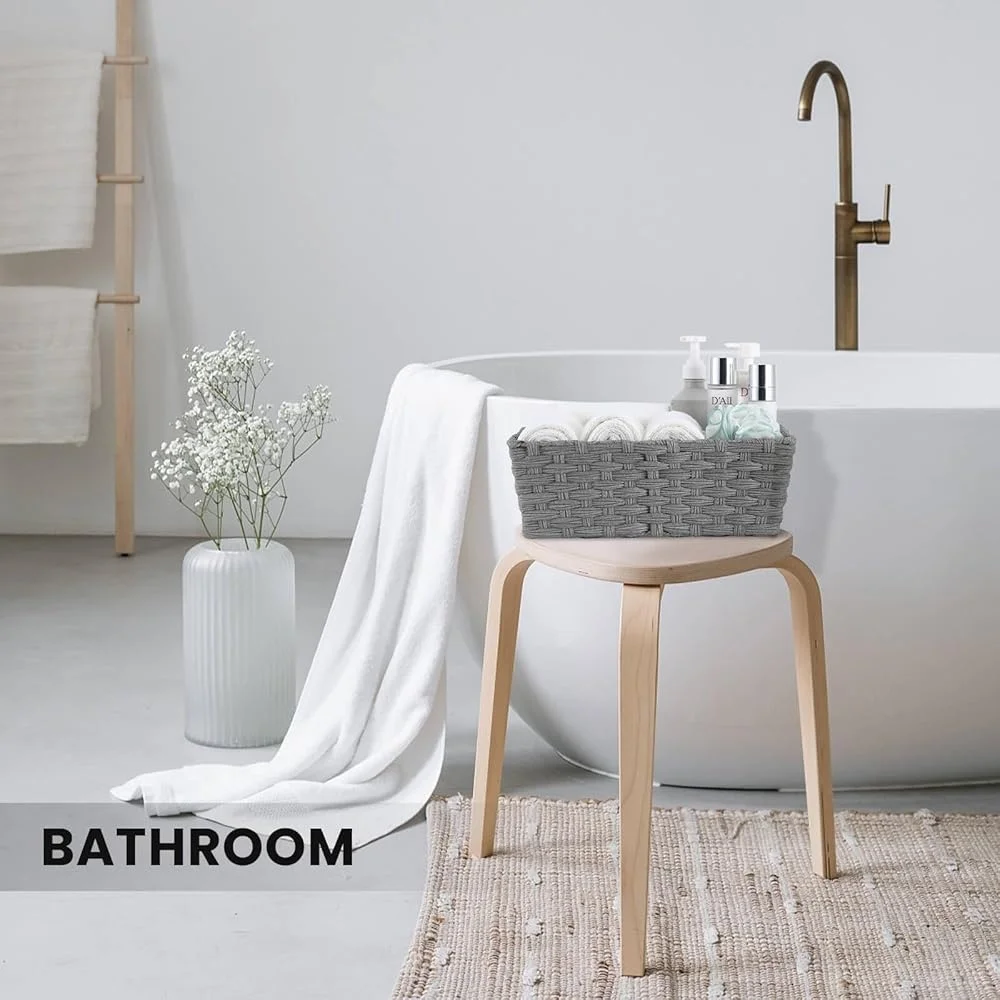
Baskets, by contrast, are movement-oriented tools designed for comfortable carrying. Their wider, shallower profile prevents clothes from getting compressed at the bottom, while sturdy handles facilitate transport. The open top design allows for quick loading and unloading, essential when transferring laundry to machines.
Finding your laundry basket vs hamper perfect companion often comes down to analyzing your specific laundry process and home layout. Many households benefit from having both: hampers for collection and baskets for transport.
When to Choose a Laundry Hamper
Laundry hampers prove particularly valuable in certain household situations. Consider a hamper when:
- You wash clothes infrequently: If you do laundry once a week or less, hampers provide better long-term storage for dirty clothes.
- Appearance matters: In visible areas of bedrooms or bathrooms, lidded hampers conceal unsightly dirty laundry.
- Odor containment is important: Particularly for households with sports equipment or heavily soiled work clothes, lidded hampers help control smells.
- You prefer pre-sorting: Multi-compartment hampers allow family members to sort lights, darks, and delicates as clothes come off.
- Floor space is limited: Tall, narrow hampers maximize vertical space while minimizing footprint in tight areas.
Families with children often benefit from hampers placed in each bedroom or bathroom, creating designated drop zones for dirty clothes. The containment factor also prevents curious pets from accessing soiled items.
For those prioritizing both function and aesthetics, our collection of wicker laundry hampers offers options that blend seamlessly with various home décor styles while providing robust storage solutions.
When to Choose a Laundry Basket
Laundry baskets shine in specific household scenarios. A basket makes more sense when:
- You frequently transport laundry: If you visit laundromats or have machines in another part of your home or building.
- Ergonomics matter: The comfortable handles and balanced design make carrying heavy loads easier.
- You handle multiple loads daily: Baskets facilitate the constant movement of clothes through the washing process.
- Space is extremely limited: Many baskets collapse or stack when not in use, saving valuable space.
- You live in a humid environment: The open design promotes better airflow, reducing mildew risk.
Single-person households often find baskets sufficient for their needs, as the volume of laundry is manageable and may not require extended storage between wash days. Similarly, apartment dwellers who use shared laundry facilities benefit from the portability baskets provide.
Our selection of wicker laundry baskets combines this essential functionality with attractive design elements that make them pleasant to use and display.
Using Both: The Optimal Laundry System
For many households, the most efficient laundry management system incorporates both hampers and baskets working in tandem. This combination capitalizes on the strengths of each piece while addressing their individual limitations.
An ideal workflow might look like this:
1. Dirty clothes are deposited in strategically placed hampers throughout the home
2. On laundry day, contents are transferred to baskets for transport to washing machines
3. Clean clothes are loaded into baskets for distribution back to their proper locations
4. The cycle repeats with empty hampers collecting new dirty items
This dual approach creates natural organization points throughout the laundry process. The hamper serves as the collection phase, keeping dirty laundry contained and sorted, while the basket facilitates the active phases of washing, drying, and distribution.
For homes with multiple floors, placing hampers on upper levels and keeping baskets near laundry facilities creates an intuitive system. Family members know exactly where to deposit dirty clothes, and the transportation tools are always where needed for laundry day.
Learning more about laundry hamper vs basket strategies can help you develop a personalized system that addresses your specific home layout and family needs.
Quality Features to Look for in Laundry Hampers
When investing in a laundry hamper, certain quality indicators ensure you’ll get lasting performance and satisfaction:
- Effective ventilation: Look for strategic air holes or mesh sections that prevent moisture buildup while still containing odors
- Sturdy lid mechanism: Hinged lids should operate smoothly and remain aligned; removable lids should fit securely
- Washable liner: A removable, machine-washable bag insert makes cleaning the hamper itself much easier
- Robust construction: Reinforced corners and quality stitching prevent warping and tearing over time
- Appropriate capacity: Size should accommodate your household’s typical volume between wash days
- Stable base: A solid bottom prevents tipping, even when the hamper is unevenly loaded
- Smooth interior: No sharp edges or protruding elements that might snag or damage clothing
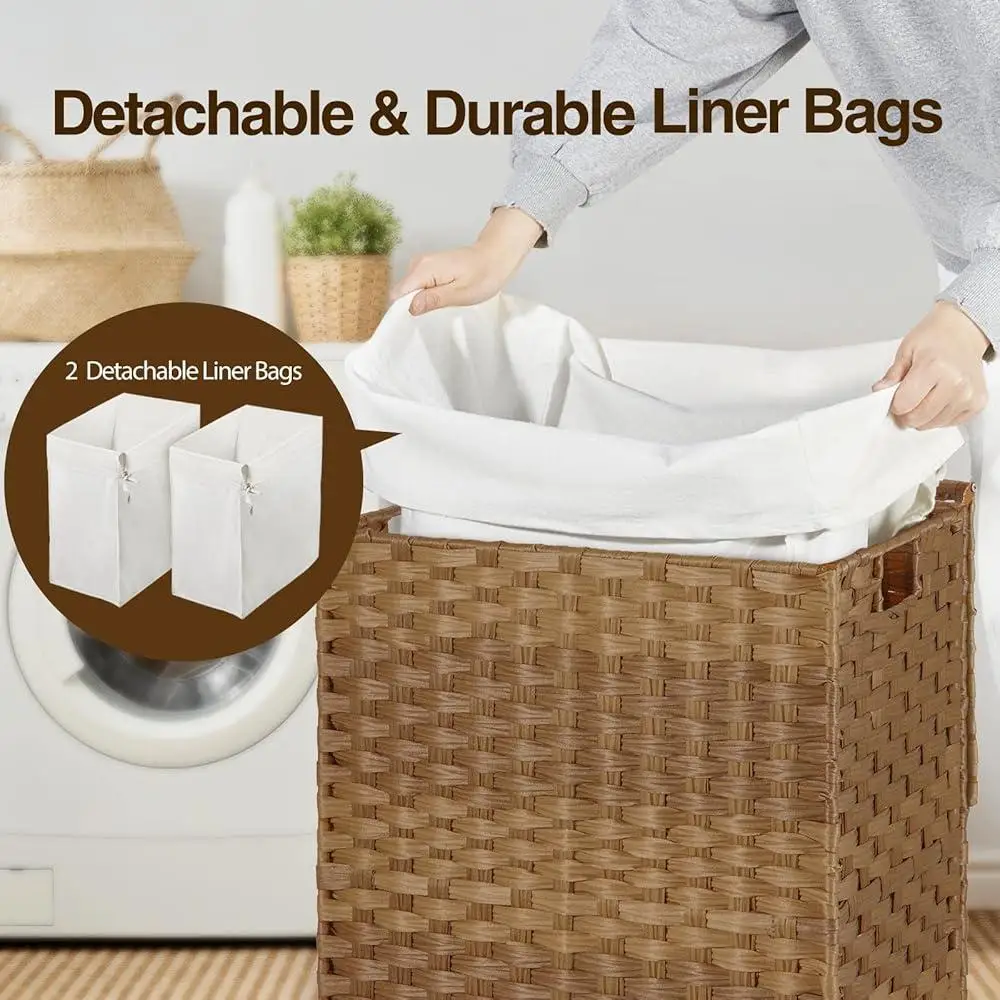
The lid design deserves special consideration based on your specific needs. Comparing lidded vs open laundry hampers helps determine whether you prioritize odor containment, quick access, or a balance between these features.
Quality Features to Look for in Laundry Baskets
When selecting a laundry basket, these quality features contribute to both functionality and longevity:
- Ergonomic handles: Look for smooth, wide handles that distribute weight comfortably
- Reinforced rim: A sturdy upper edge maintains the basket’s shape even under heavy loads
- Non-slip grips: Rubberized handle sections prevent slippage when carrying damp items
- Rounded corners: Smooth corners protect walls and doorways during transport
- Stable design: A basket should stand firmly without tipping, even when partially loaded
- Proper depth: Deep enough to contain folded laundry but not so deep that reaching bottom items becomes difficult
- Smooth finish: No rough spots or burrs that might catch on delicate fabrics
Materials significantly impact basket performance. Plastic offers water resistance and easy cleaning, while natural fibers provide better breathability and aesthetic appeal. For comprehensive guidance on making the right selection, our laundry hampers vs baskets buying guide covers these considerations in detail.
Premium Materials: Natural vs. Synthetic Options
The material of your laundry organizers affects everything from durability and maintenance to how they complement your home’s aesthetic. Here’s how natural and synthetic options compare:
| Material Type | Examples | Advantages | Considerations |
|---|---|---|---|
| Natural | Wicker, water hyacinth, seagrass, rattan | Aesthetic beauty, breathability, sustainability | May require more maintenance, higher cost |
| Synthetic | Plastic, polyester, nylon | Water-resistant, easy to clean, durable | Less breathable, potential environmental impact |
Natural materials like wicker and rattan create a warm, organic appearance that enhances home décor while providing excellent ventilation for laundry. These materials develop a beautiful patina over time and bring textural interest to functional items. Their breathability is particularly beneficial for hampers, helping prevent odor buildup in dirty clothes.
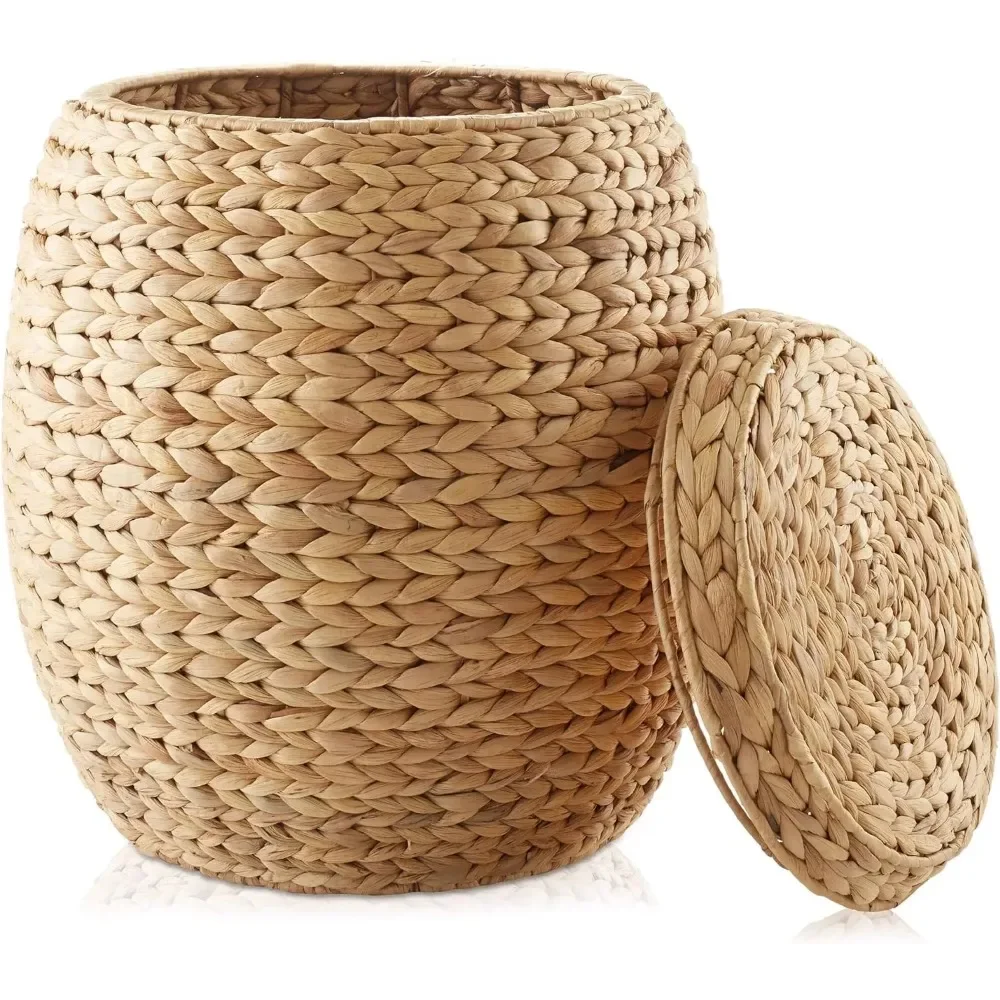
Synthetic materials offer practical advantages including moisture resistance, consistent durability, and easy cleaning. Modern plastics can be quite attractive and come in various colors to match décor schemes. They’re typically more affordable initially, though quality natural fiber products often last longer with proper care.
Understanding the differences between wicker vs woven laundry baskets can help you make an informed choice based on both practical needs and aesthetic preferences.
Is a Lid Necessary for Your Hamper?
The question of whether to choose a lidded hamper depends largely on your specific needs and preferences:
Benefits of Lidded Hampers:
– Conceals unsightly dirty laundry from view
– Contains odors from heavily soiled clothing or sports gear
– Creates a neater, more finished appearance in visible areas
– Prevents pets from accessing dirty clothes
– Adds a design element to bathroom or bedroom décor
Potential Drawbacks:
– May trap moisture if ventilation is inadequate
– Creates an extra step when depositing clothes
– Can make it difficult to see when the hamper is full
– Lid mechanisms may break over time with frequent use
Different lid styles offer varying benefits. Flip-top lids provide easy one-handed operation but may not seal as completely. Fully removable lids offer the best odor containment but require two hands to operate. Hinged lids strike a balance between convenience and containment.
For households with young children, considering should get laundry hamper lid questions includes safety factors like pinched fingers and ease of use that promotes good habits.
Can You Use a Basket as a Hamper (and Vice Versa)?
While laundry hampers and baskets are designed for specific purposes, they can sometimes substitute for each other with certain compromises:
Using a Basket as a Hamper:
– Works well for short-term storage (1-2 days)
– Provides excellent ventilation for damp items
– Takes up more floor space than a traditional hamper
– Lacks odor containment without a lid
– More visible contents may appear cluttered
Using a Hamper as a Basket:
– Possible for light loads if handles are available
– Generally less comfortable for carrying distances
– Often too deep to easily access bottom items
– May be too tall to fit under front-loading machines
– Risk of strain or awkward carrying positions
Some manufacturers offer hybrid products that attempt to combine features, such as hampers with reinforced carrying handles or baskets with optional lids. These compromises can work well in specific situations like small apartments where space limits having multiple laundry tools.
For more detailed analysis on interchangeability and versatility, explore our laundry hampers vs baskets comparison guide.
Decorative Hampers: Balancing Form and Function
Today’s laundry hampers do more than just hide dirty clothes—they can serve as attractive design elements that enhance your home’s aesthetic. Tidy Treasure specializes in laundry solutions that seamlessly blend functionality with beauty.
When selecting a decorative hamper, consider:
- Material coordination: Choose natural materials like wicker, rattan, or seagrass that complement existing wood tones and textures in your space
- Color harmony: Select neutral tones that blend with your color scheme or strategic accent colors that enhance your décor
- Design consistency: Match the style of your hamper to your overall interior design—modern, traditional, coastal, etc.
- Proportional sizing: Ensure the hamper’s scale fits appropriately within the room without overwhelming the space
- Feature enhancement: Use decorative hampers to add textural interest or natural elements to bathrooms and bedrooms
Premium decorative hampers can serve dual purposes, functioning as both practical laundry storage and attractive furniture pieces. For example, bench-style hampers provide seating while concealing laundry underneath, while cabinet-style hampers blend into bedroom furniture.
For inspiration on incorporating these elements throughout your home, browse our collection of stylish hampers and baskets for home that elevate everyday organization.
Maintaining Your Laundry Organizers for Longevity
Proper maintenance ensures your laundry organizers remain functional and attractive for years to come. Follow these material-specific care guidelines:
For Natural Fiber Hampers and Baskets:
– Dust regularly with a soft brush or vacuum attachment
– Clean spills immediately with a slightly damp cloth
– Allow thorough drying if exposed to moisture
– Apply food-grade mineral oil occasionally to prevent wicker from becoming brittle
– Keep away from direct sunlight to prevent fading and drying
For Synthetic Materials:
– Wipe with disinfectant wipes or mild soap solution periodically
– Rinse plastic baskets thoroughly after transporting damp clothes
– Check for and sand down any rough edges that develop
– Avoid placing heavy objects on top that might cause warping
For Fabric Hampers:
– Remove and wash liners according to care instructions
– Spot clean exterior fabric as needed
– Ensure complete drying before replacing liners
– Check and tighten any loose seams promptly
Prevention is key to maintaining freshness. Never leave very damp items in enclosed hampers, and consider placing a small activated charcoal sachet at the bottom of hampers to absorb odors naturally.
For comprehensive laundry organization solutions, explore our full range of laundry solutions designed to complement your home while streamlining your routine.
Wicker Laundry Baskets, Woven Laundry Baskets, Woven Storage Baskets
$392.02 Select options This product has multiple variants. The options may be chosen on the product pageLarge Wicker Laundry Baskets, Tall Wicker Baskets, Woven Laundry Hampers, Woven Storage Baskets
$130.54 Select options This product has multiple variants. The options may be chosen on the product pageWoven Laundry Baskets, Woven Laundry Washing Baskets
Price range: $136.76 through $581.37 Select options This product has multiple variants. The options may be chosen on the product pageWicker Hampers with Lids, Wicker Laundry Baskets with Lids, Wicker Laundry Hampers
$127.33 Select options This product has multiple variants. The options may be chosen on the product pageWicker Blanket Baskets, Woven Laundry Baskets
$89.60 Select options This product has multiple variants. The options may be chosen on the product pageLarge Wicker Laundry Baskets, Rattan Laundry Baskets, Woven Laundry Hampers
$162.32 Select options This product has multiple variants. The options may be chosen on the product page
Frequently Asked Questions
How many hampers or baskets does an average household need?
Most households benefit from one hamper per bedroom plus at least one laundry basket for transportation. Larger families might consider multiple baskets if handling several loads simultaneously.
What are standard sizes for hampers and baskets?
Standard hampers typically range from 20-24 inches tall and 12-18 inches wide, while laundry baskets average 24-30 inches long, 18 inches wide, and 10-12 inches deep. Capacity is often measured in bushels or loads (a standard washer load is approximately 2-2.5 cubic feet).
Are there space-saving options for small apartments?
Yes! Consider collapsible fabric hampers, over-the-door hanging hampers, corner-shaped units, or stackable baskets. Some designs combine functions, like hamper-benches that provide seating while storing laundry.
How should I manage hampers in shared bathrooms?
Choose hampers with dividers for sorting different users’ laundry, or use smaller, personalized hampers that can be easily moved to individual rooms. Water-resistant materials are especially important in humid bathroom environments.
What’s the best way to transport laundry between floors?
For multi-level homes, lightweight baskets with sturdy, comfortable handles are essential. Consider backpack-style hampers for hands-free carrying on stairs, or collapsible carts with wheels for moving multiple loads safely.

